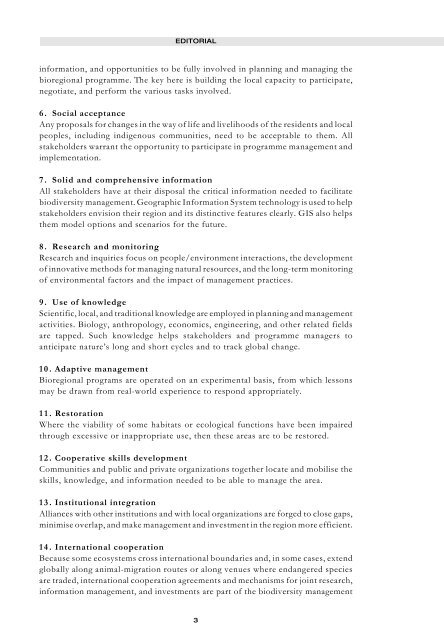Parks - IUCN
Parks - IUCN
Parks - IUCN
Create successful ePaper yourself
Turn your PDF publications into a flip-book with our unique Google optimized e-Paper software.
EDITORIAL<br />
information, and opportunities to be fully involved in planning and managing the<br />
bioregional programme. The key here is building the local capacity to participate,<br />
negotiate, and perform the various tasks involved.<br />
6. Social acceptance<br />
Any proposals for changes in the way of life and livelihoods of the residents and local<br />
peoples, including indigenous communities, need to be acceptable to them. All<br />
stakeholders warrant the opportunity to participate in programme management and<br />
implementation.<br />
7. Solid and comprehensive information<br />
All stakeholders have at their disposal the critical information needed to facilitate<br />
biodiversity management. Geographic Information System technology is used to help<br />
stakeholders envision their region and its distinctive features clearly. GIS also helps<br />
them model options and scenarios for the future.<br />
8. Research and monitoring<br />
Research and inquiries focus on people/environment interactions, the development<br />
of innovative methods for managing natural resources, and the long-term monitoring<br />
of environmental factors and the impact of management practices.<br />
9. Use of knowledge<br />
Scientific, local, and traditional knowledge are employed in planning and management<br />
activities. Biology, anthropology, economics, engineering, and other related fields<br />
are tapped. Such knowledge helps stakeholders and programme managers to<br />
anticipate nature’s long and short cycles and to track global change.<br />
10. Adaptive management<br />
Bioregional programs are operated on an experimental basis, from which lessons<br />
may be drawn from real-world experience to respond appropriately.<br />
11. Restoration<br />
Where the viability of some habitats or ecological functions have been impaired<br />
through excessive or inappropriate use, then these areas are to be restored.<br />
12. Cooperative skills development<br />
Communities and public and private organizations together locate and mobilise the<br />
skills, knowledge, and information needed to be able to manage the area.<br />
13. Institutional integration<br />
Alliances with other institutions and with local organizations are forged to close gaps,<br />
minimise overlap, and make management and investment in the region more efficient.<br />
14. International cooperation<br />
Because some ecosystems cross international boundaries and, in some cases, extend<br />
globally along animal-migration routes or along venues where endangered species<br />
are traded, international cooperation agreements and mechanisms for joint research,<br />
information management, and investments are part of the biodiversity management<br />
3

















